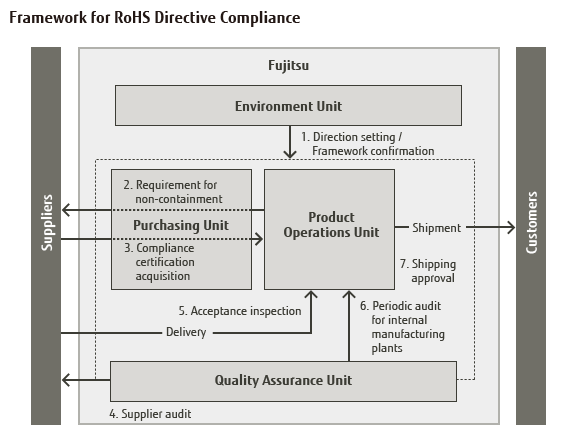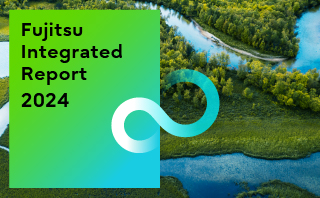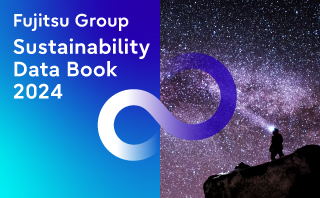-
Sustainability at Fujitsu Group
- Sustainability Management in the Fujitsu Group
- GRB(Global Responsible Business)Goals and Achievments for FY2022
- GRB(Global Responsible Business)Goals for FY2025
- Fujitsu's accessibility
- Stakeholder Engagement
- United Nations Global Compact
- SDG-related Activities in Fujitsu
- External Recognition and Awards
-
Global Responsible Business
- Environment
-
- Environmental Management
- The Fujitsu Group Environmental Vision on Climate Change
- Living in Harmony with Nature (Conservation of Biodiversity)
- Environmental Action Plan
- Environmental Data
- Environmental Communication
- Environmental Social Activities
- Disposal and Recycling of ICT products
- Environmental Considerations in ICT Products
- Governance
-
Data and Documents
- Fujitsu Group Sustainability Data Book 2024
- Social, Governance and Environmental data
- Independent Assurance Report

- GRI Standards / United Nations Global Compact (UNGC) principles Comparison Table
- SASB Standards Comparison Table
- Sustainability Information Disclosure Framework
- Link to regions responsible business reports
- Contact
- Sitemap
Reducing Specific Chemical Substances in Products
We cooperate with our business partners in striving for strict management of chemical substances whose use is restricted by laws and regulations in Japan and overseas, as well as of other potentially harmful substances.
Management of Legally Prohibited and Regulated Chemical Substances in Products
The Fujitsu Group designates substances that are harmful to people and the environment and whose use is either prohibited or regulated by law as "Fujitsu Group Specified Banned Substances." We use both Japanese and overseas regulations to determine what substances to include on this list. The "Fujitsu Group Specified Banned Substances" list is comprised of two categories ‐ one for substances commonly prohibited throughout the world and another for substances prohibited in certain countries or regions.
We have also established a Fujitsu Group Green Procurement Direction and strengthened control of the chemicals in our products by taking the initiative in directing our suppliers to construct chemical management systems (CMSs). By excluding banned substances through green procurement activities, we are providing products free of Fujitsu Group Specified Banned Substances.
In response to regulations such as the RoHS Directive (*1) , we have taken systematic action covering the entire supply chain by constructing a system headed by our product business division and including our quality assurance, purchasing, and environmental divisions, to manage chemical substances from design through to delivery. In FY 2012, we revised our internal systems to comply with the CE marking (*2) requirements of the revised RoHS Directive. We changed them from the previous configuration, based on internal standards, to systems suited to standards consistent with the RoHS Directive. As a result, we were in compliance with the revised RoHS Directive, including CE marking provisions, when the revised directive came into effect.
- (*1)RoHS Directive:
Restriction of the use of certain hazardous substances in electrical and electric equipment - (*2)CE marking:
Mark that is applied to products to show they are in compliance with the safety requirements of EU (EC) directives.

Controlling Substances of Concern
The Fujitsu Group sees the minimization of risk associated with specified chemical substances as a high priority for protecting the safety of customers. Therefore, when we have concerns about the harmfulness of substances, we designate them as Fujitsu Group Specified Controlled Substances or Fujitsu Group Specified Reportable Substances, even if they have not been scientifically shown to be harmful. Based on the principle of prevention, we manage our use of chemical substances in a way that allows us to ban their use immediately if it becomes clear they are harmful.
The Fujitsu Group Specified Reportable Substances list includes substances that are REACH regulation (*3) candidate substances (*4) , and we collect information on substance amounts from suppliers and then manage these quantities on a per-product basis. Moreover, the Specified Controlled Substances list also includes data from suppliers on amounts for substances that may not be restricted by every country's regulations, but which we consider to be of concern.
As far as PVC is concerned, we not only control the amounts included in our products but also require in our Green Procurement Direction that it be used as little as possible, and restrict its use in everything except sheathing for cables and insulating materials for electronic components.
- (*3)REACH regulation:
Regulation concerning the Registration, Evaluation, Authorization, and Restriction of Chemicals - (*4)REACH candidate substances for Authorization:
Selected chemical substances with properties (carcinogenicity, mutagenicity, reproductive toxicity, etc.) regulated by REACH. If these substances are present in products, data on the amounts must be displayed.
Using ICT to Control the Chemicals in Our Products
From requesting surveys by outside organizations through to gathering information by our own efforts, the Fujitsu Group maintains an integrated system for managing the information on the chemicals contained in the components and materials it purchases from its suppliers throughout its supply chain. Further, we use the large volumes of chemical-related data we collect to calculate amounts on a per-product basis, pinpointing the amounts of designated chemicals at the product level and managing them accordingly.
The Group also offers a green procurement / management of chemical substances contained in products solution called FUJITSU Manufacturing Industry Solution COLMINA, a software package that utilizes this in-house expertise.
Contributing to Creating Mechanisms for Chemical Substance Management
In the Fujitsu Group, we see efforts towards chemical substance management as an issue for the whole supply chain and so participate in activities such as the Joint Article Management Promotion-consortium (JAMP) to contribute to the construction and widespread adoption of mechanisms that can transmit information effectively.
The Fujitsu Group uses ChemSHERPA![]() , a common communication scheme for chemical substances contained in products popularized and promoted by JAMP, to grasp and manage the presence or absence of chemical substances contained in products and their usage, including not only those subject to the REACH Regulation but also those designated as "Fujitsu Group specified controlled substances" which may have harmful effects. Furthermore, based on the data collected by ChemSHERPA on the chemical substances contained in procured products, we will promote the substitution of procured products containing chemical substances found to be hazardous to minimize the impact of chemical substances on people and the environment.
, a common communication scheme for chemical substances contained in products popularized and promoted by JAMP, to grasp and manage the presence or absence of chemical substances contained in products and their usage, including not only those subject to the REACH Regulation but also those designated as "Fujitsu Group specified controlled substances" which may have harmful effects. Furthermore, based on the data collected by ChemSHERPA on the chemical substances contained in procured products, we will promote the substitution of procured products containing chemical substances found to be hazardous to minimize the impact of chemical substances on people and the environment.


